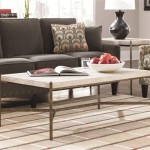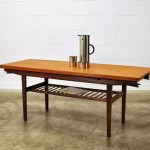What Is A Good Size For A Coffee Table?
Selecting the appropriate size coffee table is crucial for creating a functional and aesthetically pleasing living space. A coffee table that is too large can overwhelm the room and obstruct movement, while one that is too small may be impractical and visually insignificant. Several factors influence the ideal coffee table size, including the dimensions of the sofa or seating arrangement, the overall room size, and the intended use of the table. Understanding these factors allows for a well-informed decision that enhances both the comfort and style of the living area.
The process of determining the perfect coffee table size involves considering several key dimensions: length, width, and height. Each of these dimensions plays a distinct role in the table's functionality and its relationship to the surrounding furniture and space. Incorrect sizing can disrupt the flow of the room and compromise the table's usefulness. Therefore, a thoughtful assessment of each dimension is essential for achieving the desired outcome.
Sofa Length and Coffee Table Length Relationship
The length of the sofa is perhaps the most important factor in determining the ideal length of the coffee table. A common rule of thumb is that the coffee table should be approximately two-thirds to three-quarters the length of the sofa. This proportion creates a visual balance and ensures that the table is easily accessible from all seating positions. For instance, if the sofa is 84 inches long, the coffee table should ideally be between 56 and 63 inches in length.
Deviating significantly from this guideline can lead to an unbalanced aesthetic. A coffee table that is significantly shorter than two-thirds the sofa length can appear lost and insignificant in the space. Conversely, a coffee table that extends beyond three-quarters the sofa length might crowd the room and impede movement. Maintaining this proportional relationship ensures that the coffee table complements the sofa and contributes to a harmonious overall design.
It is important to consider the style of the sofa when determining the appropriate coffee table length. A modern, minimalist sofa with clean lines may benefit from a coffee table that closely adheres to the two-thirds guideline, emphasizing its sleek design. A more traditional or oversized sofa, however, may accommodate a slightly longer coffee table without appearing disproportionate. The architectural details and overall aesthetic of the sofa should guide the final length selection.
Furthermore, the placement of other furniture in the room can influence the ideal coffee table length. If there are armchairs or side tables flanking the sofa, a slightly shorter coffee table might be preferable to ensure adequate space for movement. Conversely, if the sofa is the primary seating element in the room, a longer coffee table can provide ample surface area for beverages, books, and decorative items. The overall layout of the room should be considered to optimize both functionality and visual appeal.
Optimal Coffee Table Width and Room Size
The width of the coffee table is another critical dimension that should be carefully considered in relation to the room size and the positioning of other furniture. A general guideline is that the width should be sufficient to provide ample surface area without obstructing the flow of traffic. A coffee table that is too wide can make it difficult to navigate the room, particularly in smaller spaces. The ideal width typically ranges between 22 and 30 inches, but this can vary depending on the room's specific dimensions.
In smaller rooms, a narrower coffee table is generally preferable. This allows for a more open and airy feel, preventing the space from feeling cramped. A wider coffee table in a small room can create a sense of congestion, making it difficult to move around comfortably. Choosing a narrower option, such as one between 22 and 26 inches wide, can help maintain a sense of spaciousness while still providing a functional surface.
Larger rooms can accommodate wider coffee tables without compromising the flow of traffic. In these spaces, a wider table can serve as a focal point and provide ample surface area for various uses. A width between 28 and 30 inches, or even slightly wider in some cases, can be suitable for larger rooms. The key is to ensure that there is still enough space to comfortably walk around the table without feeling restricted.
The shape of the coffee table can also influence the perceived width. A rectangular coffee table, for example, may appear wider than a round or oval coffee table of the same dimensions. This is because the straight edges of a rectangular table can emphasize its width more than the curved edges of a round or oval table. When selecting the width, consider the shape of the table and how it will impact the overall visual impression of the room.
The Importance of Coffee Table Height
The height of the coffee table is a crucial factor for both comfort and functionality. A coffee table that is too high can be awkward to use, while one that is too low may be difficult to reach. The ideal height is typically within a few inches of the sofa seat height. This allows for comfortable access to items placed on the table without having to reach up or bend down excessively. A coffee table that is approximately the same height as the sofa seat is often considered the most ergonomic choice.
A general guideline is that the coffee table should be between 16 and 18 inches in height. This range is suitable for most standard sofas, providing a comfortable and accessible surface. However, the specific height of the sofa seat should be taken into account when making the final decision. If the sofa seat is higher than average, a slightly taller coffee table may be necessary to maintain the desired level of comfort.
Lower sofas, which are often found in modern or contemporary designs, may require a coffee table that is shorter than the standard range. A coffee table that is 14 to 16 inches in height may be more appropriate for these types of sofas. The goal is to ensure that the coffee table is easily accessible without feeling disproportionate to the sofa. A low coffee table paired with a high sofa can create an awkward and unbalanced aesthetic.
The intended use of the coffee table can also influence the ideal height. If the table is primarily used for dining or working, a slightly taller height might be preferable. A table that is 18 to 20 inches in height can provide a more comfortable surface for these activities. However, it is important to ensure that the taller coffee table does not obstruct the view of the television or other focal points in the room. Balancing functionality with aesthetics is key to selecting the perfect height.
Ultimately, determining the appropriate coffee table size requires careful consideration of the sofa dimensions, room size, and intended use. By taking these factors into account, selecting the ideal length, width, and height to achieve a balanced and functional living space becomes possible.

Coffee Table Dimension Guide Ashley Home

Coffee Table Dimension Guide Ashley Home

How To Buy A Coffee Table Living Spaces

How To Choose The Right Size Shape Coffee Table For Your Living Space

The Ultimate Coffee Table Size Guide Apt2b

How To Buy A Coffee Table Living Spaces

Coffee Table Dimensions How To Choose The Right Size Tidbits Twine

Coffee Table Dimensions Size Guide Measurements

How To Choose The Right Size Shape Coffee Table For Your Living Space

Coffee Table Dimensions How To Choose The Right Size Tidbits Twine
Related Posts








